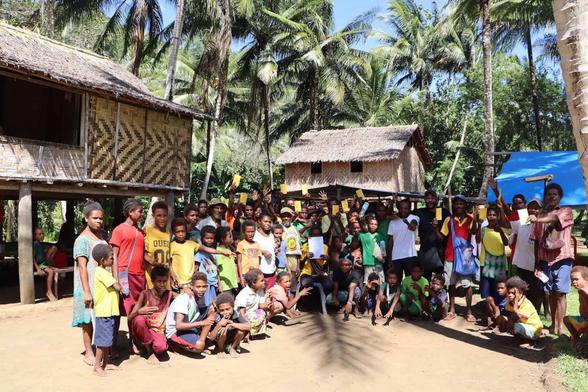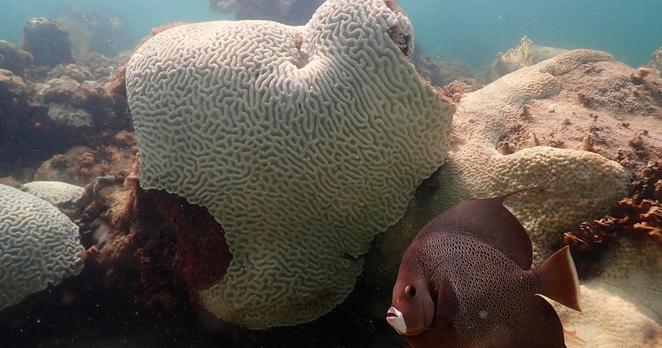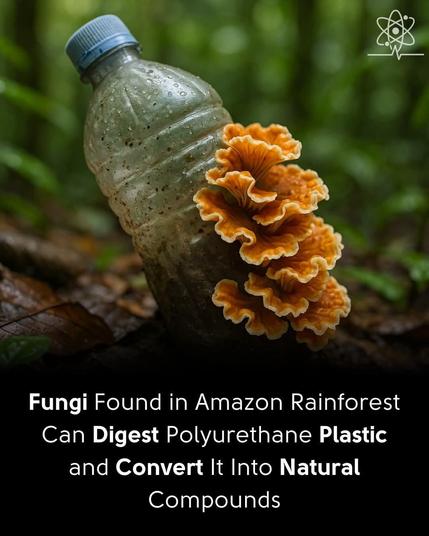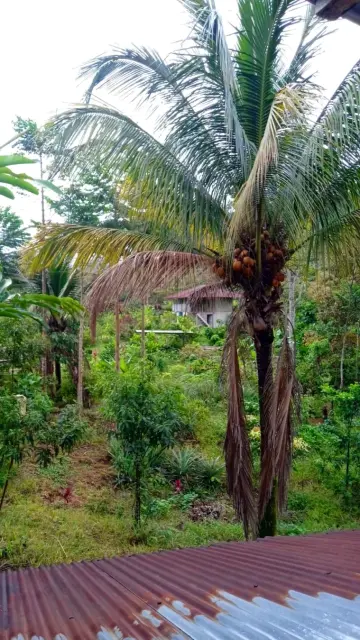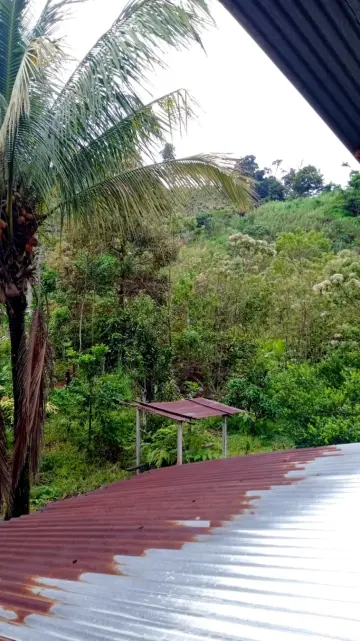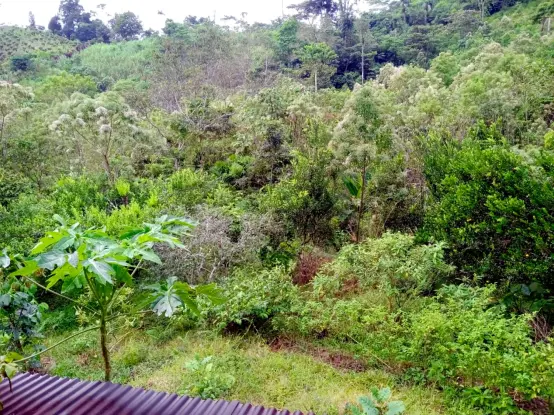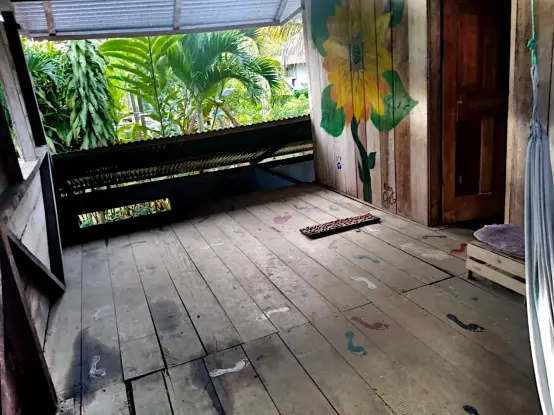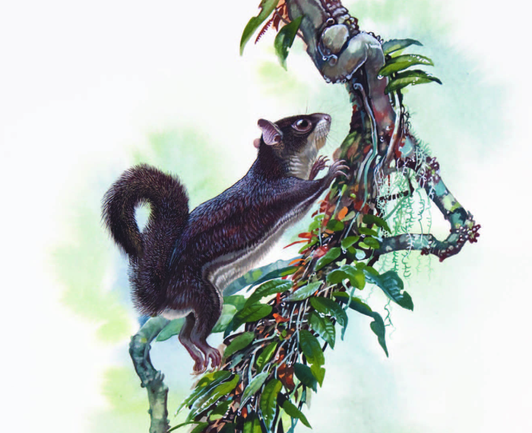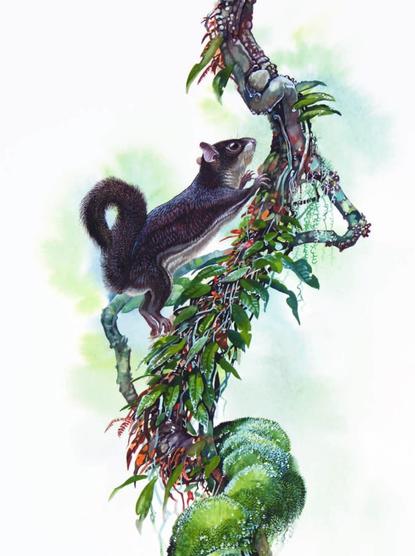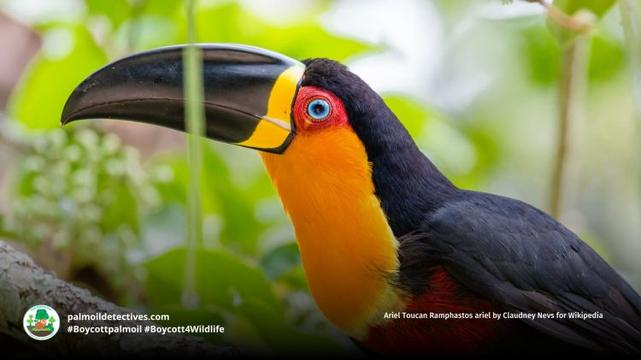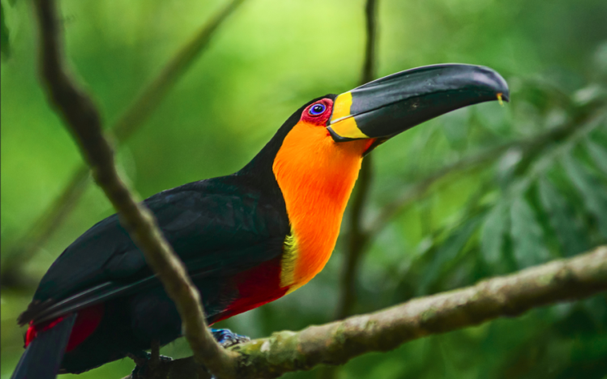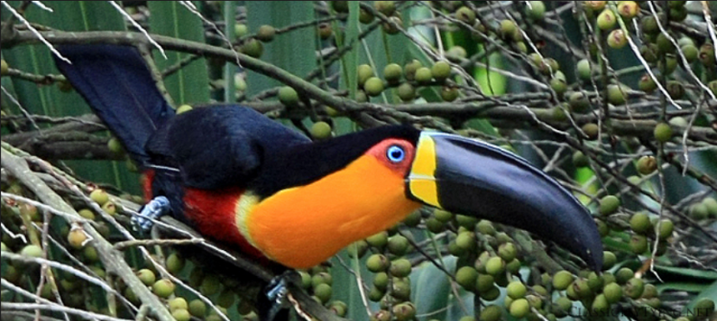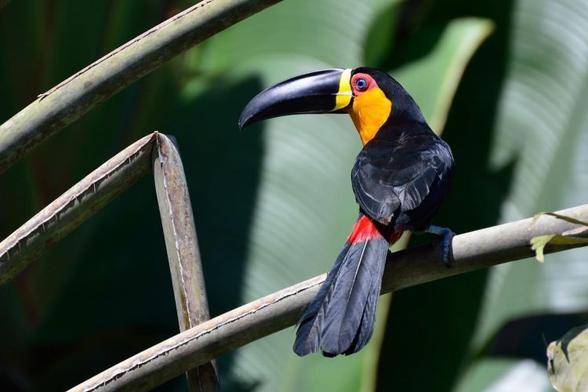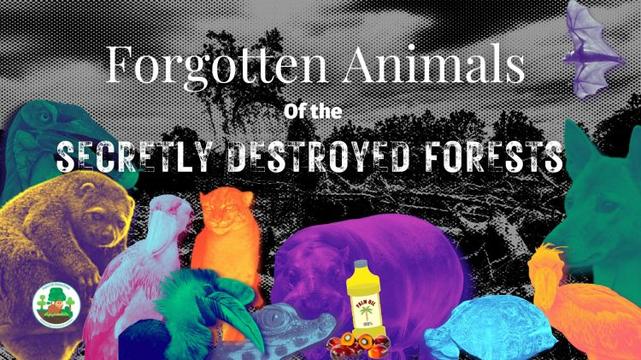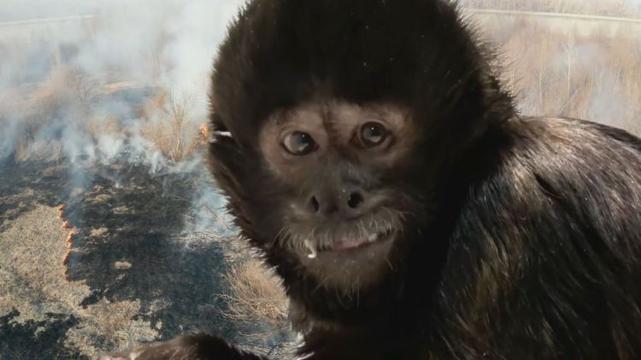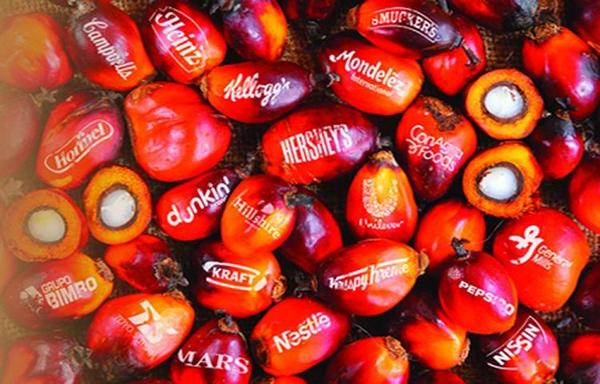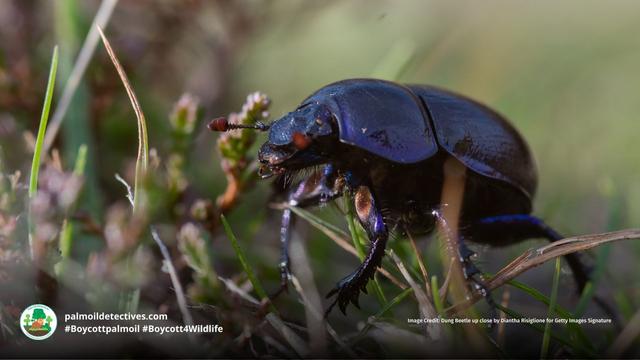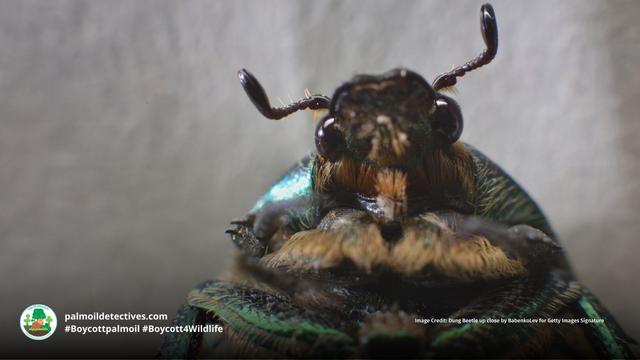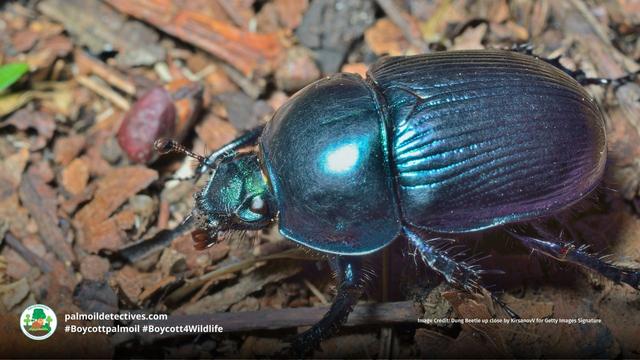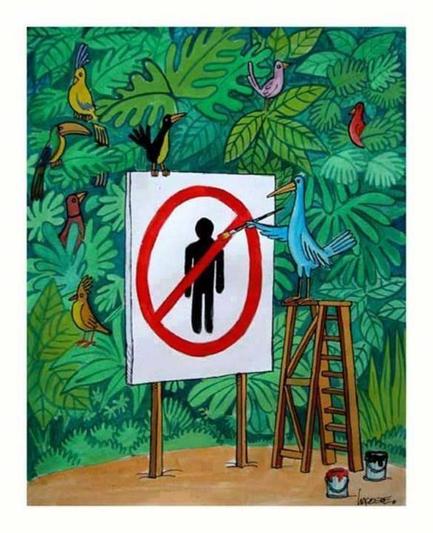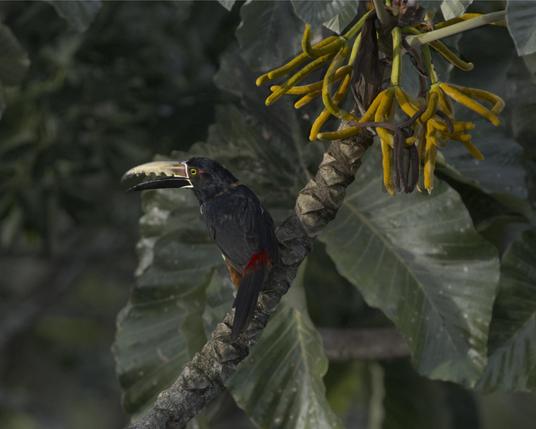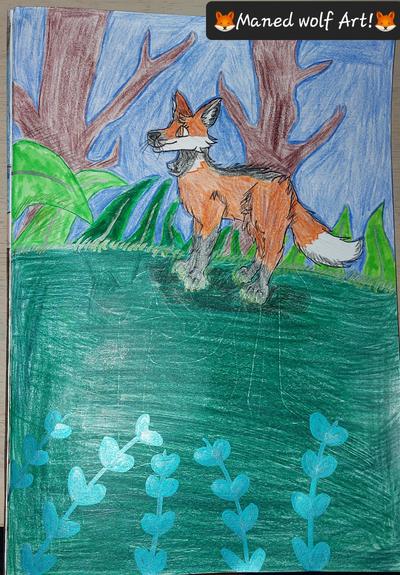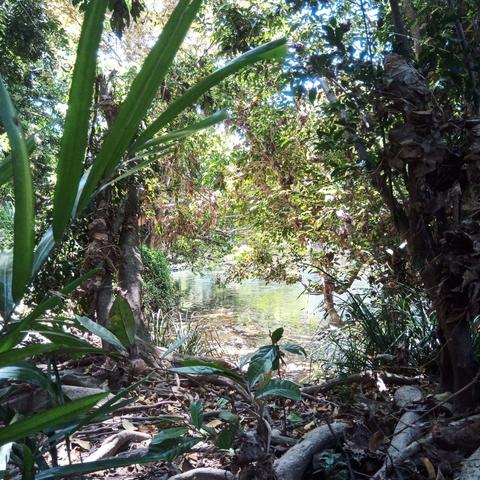The bold model stopping deforestation in its tracks
#rainforest
And almost everybody don't give a fuck, but the last version of chatGPT, yes. We are heading towards a catastrophic 21st century.
Planet’s first catastrophic climate tipping point reached, report says, with coral reefs facing ‘widespread dieback’ | Climate crisis | The Guardian
https://www.theguardian.com/environment/2025/oct/13/coral-reefs-ice-sheets-amazon-rainforest-tipping-point-global-heating-scientists-report
Coral reefs become first environmental system on Earth to pass climate “tipping point,” report says
Coral reefs around the globe have for years suffered publicly in warming oceans, periodically making headlines when iconic…
#NewsBeep #News #Headlines #Climatechange #CoralReef #globalwarming #Rainforest #SEVEREWEATHER #UnitedNations #World
https://www.newsbeep.com/182463/
Who is setting the Amazon on fire?
—> You don’t need to be Hercule Poirot to figure this one out, but it’s still an interesting article by AFP
https://www.france24.com/en/live-news/20251013-who-is-setting-fire-to-the-amazon
#Climate #ClimateCrisis #Farming #Agriculture #Forest #Rainforest #Brazil #Bresil #Amazon #Wildfires #Biodiversity #Conservation
Another reason to protect rainforests..A group of Yale University students discovered a fungus in the Amazon rainforest that can degrade polyurethane
even in landfills where oxygen is limited. It metabolizes the plastic and turns it into organic matter as part of its natural digestive system
#EnvironmentalScience #rainforest #science_memes #plasticpollution
World's first catastrophic climate tipping point reached, report says. The "Global Tipping Points" report published by the University of Exeter found that warm-water coral reefs are passing their tipping point and face a longterm decline. It seems like the most alive parts of the planet - coral reefs and Amazon rain forests - die first.
#ClimateCrisis #Coral #Rainforest
https://global-tipping-points.org/
Amazon Rainforest hits record carbon emissions from 2024 forest fires https://news.mongabay.com/short-article/2025/10/amazon-rainforest-hits-record-carbon-emissions-from-2024-forest-fires/
#Amazon #forest #rainforest #environment #carbon #emissions #wildfire #wildfires
https://amazonrestore.codeberg.page/volunteer/finca-del-soul/
#veganarchist #veganarchism #vegantravel
#fruiterrarist #fruiterrarism
#gardening #FruitForest #GrowYourOwn
#ecuador #Amazonia #AmazonRainforest #jungle
#SolarpunkSunday #TreesNotGrass
Mentawi Flying Squirrel Iomys sipora
Mentawi Flying Squirrel Iomys sipora
IUCN Status: Endangered
Location: Indonesia (Mentawai Islands: Sipura and North Pagai)
The #Mentawi Flying #Squirrel (Iomys sipora), endemic to the remote Mentawai Islands of Indonesia, is a rare and elusive species that glides effortlessly through the dense tropical canopy. Unlike their more widespread relatives, these unique flying squirrels are confined to just two islands, #Sipura and North Pagai, where they depend entirely on the survival of lowland primary forests. With velvety fur, large nocturnal eyes, and a patagium—an outstretched skin membrane allowing them to glide between trees—these squirrels are adapted to a life above the ground. However, relentless deforestation for palm oil plantations, logging, and agriculture has devastated their habitat, putting them at serious risk of extinction. Despite repeated surveys, including a 1991 study by the National Museum of #Indonesia, sightings of Iomys sipora are alarmingly rare, raising fears that their population may be critically low—or even lost. With no conservation measures in place, urgent action is needed to prevent their disappearance. Boycott #deforestation-linked products and support indigenous-led conservation. #BoycottPalmOil #Boycott4Wildlife.
Gliding between trees in #Indonesia 🇮🇩with effortless grace, the Mentawi Flying #Squirrel 🦦is a sight to behold. They need #rainforest to survive. #PalmOil is a threat, make sure you #BoycottPalmOil 🌴🪔💀🤮🧐🙊⛔️ #Boycott4Wildlife @palmoildetect https://palmoildetectives.com/2021/02/05/mentawi-flying-squirrel-iomys-sipora/
Share to BlueSky Share to TwitterThis squirrel is threatened by forest loss due to logging and agricultural conversion.
IUCN Red list
Appearance and Behaviour
The world’s gliding mammals are an extraordinary group of animals that have the ability to glide from tree to tree with seemingly effortless grace. There are more than 60 species of gliding mammals including the flying squirrels from Europe and North America, the scaly-tailed flying squirrels from central Africa and the gliding possums of Australia and New Guinea.
The Mentawi Flying Squirrel is a striking and little-documented species with dense, velvety fur ranging from reddish-brown to deep grey. Their large, round eyes are adapted for night vision, enabling them to forage under the cover of darkness. A defining feature of this species is its patagium— a thin membrane of skin stretching between its limbs—that allows them to glide through the air with remarkable agility. This natural adaptation enables them to travel between trees without descending to the forest floor, avoiding predators while seeking food. Despite their impressive gliding ability, their dependence on intact rainforest means they struggle to survive in fragmented landscapes, making habitat loss a critical threat.
Threats
The Mentawi Flying Squirrel lives in primary forests up to 500 m. Habitat loss on the two islands represents a major threat to this lowland species.
Palm Oil Deforestation and Habitat Destruction
The Mentawai Islands are experiencing rapid deforestation, with lowland primary forests being cleared for palm oil plantations, logging, and agriculture. Iomys sipora relies entirely on undisturbed rainforest, and the loss of old-growth trees has significantly reduced available nesting sites and food sources. Once widespread, they are now found in just two fragmented locations, and their numbers are declining.
Illegal Wildlife Trade Extirpation
A 1991 survey failed to locate any individuals, raising concerns that populations may already be critically low or locally extinct. Habitat degradation and fragmentation mean that surviving populations are likely small and isolated, making recovery efforts increasingly difficult.
Agricultural Expansion and Infrastructure
Beyond palm oil, the Mentawai Islands face destruction from logging, rubber plantations, and road development, which further degrade the remaining habitat. Unlike more adaptable rodents, these flying squirrels cannot survive in secondary forests, making primary forest loss particularly devastating.
Climate Change and Extreme Weather Patterns
Climate change is altering rainfall patterns and increasing temperatures, which could further threaten this species’ delicate forest ecosystem. Rising temperatures may also affect fruiting seasons, reducing their food supply and further impacting their already struggling population.
Diet
Like other flying squirrels, Iomys sipora is primarily herbivorous, feeding on a mix of fruits, seeds, leaves, and flowers. Their diet plays a vital role in seed dispersal, helping regenerate their native rainforest. They rely on old-growth trees, which provide an abundance of food sources, but as these trees are felled, their dietary options become severely limited.
Reproduction and Mating
Due to the extreme rarity of Iomys sipora, very little is known about their reproductive habits. However, they are presumed to be solitary nesters, using tree hollows to raise their young. Like other flying squirrels, females likely give birth to one or two pups per litter, which remain dependent on their mothers until they develop the ability to glide and forage independently. The loss of old-growth trees also removes critical nesting sites, impacting their reproductive success and ability to recover from population losses.
Geographic Range
The Mentawi Flying Squirrel is restricted to two islands in Indonesia:
• Sipura Island
• North Pagai Island
Both islands are part of the Mentawai Archipelago, located off the coast of Sumatra. Their habitat is limited to lowland tropical primary forests below 500 metres above sea level, an ecosystem rapidly disappearing due to human activity.
FAQs
Why is the Mentawi Flying Squirrel endangered?
This species is classified as endangered due to its highly restricted range and ongoing deforestation. Logging, palm oil plantations, and habitat destruction have driven it to the brink, with no known conservation measures in place to protect its remaining populations.
Do Mentawi Flying Squirrels make good pets?
No. The illegal pet trade has devastating effects on wildlife, and keeping a Mentawi Flying Squirrel as a pet would contribute to their decline. These animals are highly specialised and cannot survive in captivity, often dying due to stress or inadequate care. Removing individuals from the wild further destabilises already fragile populations. If you care about their survival, support habitat protection and never purchase exotic pets.
How does palm oil impact the Mentawi Flying Squirrel?
Palm oil plantations are a primary driver of deforestation in Indonesia, replacing biodiverse rainforests with monoculture wastelands that provide no habitat for native species. These plantations have destroyed much of the Mentawai Islands’ primary forest, leaving little space for this already endangered species. Boycotting palm oil products is a direct way to protect their habitat.
How can we protect the Mentawi Flying Squirrel?
The most important conservation efforts include:
• Protecting remaining old-growth forests on the Mentawai Islands.
• Supporting indigenous-led conservation efforts, which are crucial for preserving biodiversity.
• Boycotting palm oil and timber products linked to deforestation.
• Encouraging reforestation projects in degraded areas to restore lost habitat.
Support the conservation of this species
This animal has no protections in place. Read about other forgotten species here. Create art to support this forgotten animal or raise awareness about them by sharing this post and using the #Boycottpalmoil #Boycott4Wildlife hashtags on social media. Also you can boycott palm oil in the supermarket.
Further Information
Lee, B. 2016. Iomys sipora (errata version published in 2017). The IUCN Red List of Threatened Species 2016: e.T10846A115099877. https://dx.doi.org/10.2305/IUCN.UK.2016-3.RLTS.T10846A22249119.en. Downloaded on 04 February 2021.
Ruedas, L., Duckworth, J. W., Lee, B., & Tizard, R. J. (2008). Iomys sipora. The IUCN Red List of Threatened Species. Retrieved from https://pmc.ncbi.nlm.nih.gov/articles/PMC8317177/.
Wikipedia. (2024). Mentawi Flying Squirrel. Retrieved from https://en.wikipedia.org/wiki/Mentawi_flying_squirrel.
Mentawi Flying Squirrel Iomys sipora
Caption: This beautiful painting is by My YM
How can I help the #Boycott4Wildlife?
Take Action in Five Ways
1. Join the #Boycott4Wildlife on social media and subscribe to stay in the loop: Share posts from this website to your own network on Twitter, Mastadon, Instagram, Facebook and Youtube using the hashtags #Boycottpalmoil #Boycott4Wildlife.
2. Contribute stories: Academics, conservationists, scientists, indigenous rights advocates and animal rights advocates working to expose the corruption of the palm oil industry or to save animals can contribute stories to the website.
Mel Lumby: Dedicated Devotee to Borneo’s Living Beings
Anthropologist and Author Dr Sophie Chao
Health Physician Dr Evan Allen
The World’s Most Loved Cup: A Social, Ethical & Environmental History of Coffee by Aviary Doert
How do we stop the world’s ecosystems from going into a death spiral? A #SteadyState Economy
3. Supermarket sleuthing: Next time you’re in the supermarket, take photos of products containing palm oil. Share these to social media along with the hashtags to call out the greenwashing and ecocide of the brands who use palm oil. You can also take photos of palm oil free products and congratulate brands when they go palm oil free.
https://twitter.com/CuriousApe4/status/1526136783557529600?s=20
https://twitter.com/PhillDixon1/status/1749010345555788144?s=20
https://twitter.com/mugabe139/status/1678027567977078784?s=20
4. Take to the streets: Get in touch with Palm Oil Detectives to find out more.
5. Donate: Make a one-off or monthly donation to Palm Oil Detectives as a way of saying thank you and to help pay for ongoing running costs of the website and social media campaigns. Donate here
Pledge your support#Agriculture #Boycott4wildlife #BoycottPalmOil #deforestation #EndangeredSpecies #ForgottenAnimals #glidingMammal #Indonesia #Mammal #Mentawi #MentawiFlyingSquirrelIomysSipora #palmoil #rainforest #rodent #rodents #Sipura #SouthEastAsia #Squirrel #Sumatra
Ariel Toucan Ramphastos ariel
Near Threatened
Location: South America, primarily in Brazil, with occurrences in Venezuela, Guyana, and northern Argentina
No conservation
The Ariel Toucan (Ramphastos ariel) is a vibrant and charismatic bird native to South America, celebrated for their multi-coloured bill and ecological importance as seed dispersers. Found in tropical and subtropical forests, these toucans contribute significantly to forest regeneration, ensuring the survival of diverse plant species.
However, habitat loss due to deforestation for gold mining, soy and meat agriculture, and palm oil plantations has led to population declines, resulting in their classification as Near Threatened. Protect these iconic rainforest birds by boycotting palm oil, go vegan for them and support indigenous-led agroecology. #BoycottPalmOil #Boycott4Wildlife #BoycottGold4Yanomami and be #vegan
The magnificent Ariel Toucan’s glossy black plumage 🌈🦜✨ contrasts with a fiery orange 🧡 throat. #Palmoil #soy and #meat #deforestation in #Brazil are threats. Help them to survive! Be #vegan #BoycottPalmOil 🌴🪔🚫#Boycott4Wildlife @palmoildetect https://palmoildetectives.com/2021/04/01/ariel-toucan-ramphastos-ariel/
Share to BlueSky Share to TwitterAn iconic #bird 🦜💚of the #Amazon #rainforest #SouthAmerica the Ariel #Toucan is endangered from #hunting #beef and #soy #palmoil #deforestation. Support this icon and be #vegan 🌱🍉 #BoycottPalmOil 🌴🪔☠️🤮⛔️ #Boycott4Wildlife @palmoildetect https://palmoildetectives.com/2021/04/01/ariel-toucan-ramphastos-ariel/
Share to BlueSky Share to TwitterAppearance and Behaviour
Ariel Toucans are medium-sized birds, measuring 40–50 cm in length, with a strikingly large bill accounting for up to one-third of their body length. Their glossy black plumage contrasts with a fiery orange to red throat and chest. This vibrant coloration makes the Ariel Toucan visually stunning.
These toucans are highly social and live in pairs or small flocks. They communicate using a variety of croaks and yelps and are often seen hopping between branches in the forest canopy. Their large, lightweight bills are perfectly adapted for plucking fruits from hard-to-reach branches, showcasing their evolutionary specialisation for frugivory.
Geographic Range
The Ariel Toucan inhabits tropical rainforests, lowland forests, and fragmented secondary forests across South America. Their range includes regions south of the Amazon in Brazil, extending to parts of Venezuela, Guyana, and northern Argentina.
While their range remains relatively broad, habitat destruction and fragmentation, particularly in the Atlantic Forest and Amazon Basin, have isolated populations and reduced their available habitat.
Diet
Ariel Toucans are predominantly frugivorous, relying on fruits such as figs, guavas, and berries. They also consume small invertebrates, eggs, and nestlings when fruit is scarce.
Their role as seed dispersers is critical for forest regeneration. By consuming fruits and dispersing seeds over large areas, they support biodiversity and the growth of numerous tree species. However, deforestation disrupts their access to diverse food sources, threatening their ecological function.
Reproduction and Mating
During the breeding season, Ariel Toucans nest in tree cavities, often repurposing old woodpecker holes. Females lay 2–4 eggs, which are incubated by both parents over a period of 16–18 days.
The chicks remain in the nest for several weeks after hatching, with both parents actively feeding and protecting them. Juveniles develop their vibrant plumage and distinctive bills as they mature, gaining full independence after several months.
Threats
Although the Ariel Toucan is currently classified as Near Threatened, population declines are ongoing. Conservation priorities include protecting and restoring rainforest habitats, particularly in regions like the Amazon and Atlantic Forest. Strengthening anti-deforestation measures are critical for their survival.
Efforts to combat the illegal pet trade and raise awareness of their ecological importance are also vital. Continued monitoring and research are necessary to track population trends and threats effectively.
IUCN Status: Near Threatened
Habitat Destruction:
Large-scale deforestation in the Amazon Basin and Atlantic Forest for soy and palm oil agriculture, logging, and cattle ranching significantly reduces their habitat.
Palm Oil Plantations:
The conversion of forested areas into palm oil plantations further accelerates habitat loss.
Illegal Pet Trade:
Ariel Toucans are captured for the pet trade, which disrupts local populations.
Habitat fragmentation and isolation:
Fragmented habitats restrict movement and genetic exchange, increasing the risk of local extinctions.
Climate Change:
Altered rainfall patterns and rising temperatures affect fruiting cycles and habitat suitability, adding further pressure on populations.
Take Action!
Help protect the Ariel Toucan by boycotting palm oil and supporting reforestation projects. Advocate for stricter wildlife protections and raise awareness about their plight. Together, we can ensure a future for this iconic species. #BoycottPalmOil #Boycott4Wildlife
The primary threat to this species is accelerating deforestation in the Amazon basin as land is cleared for cattle ranching and soy production, facilitated by expansion of the road network (Soares-Filho et al. 2006, Bird et al. 2011).
IUCN red list
Support the conservation of this species
This animal has no protections in place. Read about other forgotten species here. Create art to support this forgotten animal or raise awareness about them by sharing this post and using the #Boycottpalmoil #Boycott4Wildlife hashtags on social media. Also you can boycott palm oil in the supermarket.
Further Information
BirdLife International. 2023. Ramphastos ariel. The IUCN Red List of Threatened Species 2023: e.T22726233A221624536. https://dx.doi.org/10.2305/IUCN.UK.2023-1.RLTS.T22726233A221624536.en. Accessed on 28 December 2024.
BirdLife International. (2024). Ariel Toucan (Ramphastos ariel).
Birds of the World. (2024). Ariel Toucan introduction.
Merazonia wildlife rescue and sanctuary rehabilitate parrots and toucans, some of the most trafficked animals in the world. Donate to them here
How can I help the #Boycott4Wildlife?
Take Action in Five Ways
1. Join the #Boycott4Wildlife on social media and subscribe to stay in the loop: Share posts from this website to your own network on Twitter, Mastadon, Instagram, Facebook and Youtube using the hashtags #Boycottpalmoil #Boycott4Wildlife.
2. Contribute stories: Academics, conservationists, scientists, indigenous rights advocates and animal rights advocates working to expose the corruption of the palm oil industry or to save animals can contribute stories to the website.
Mel Lumby: Dedicated Devotee to Borneo’s Living Beings
Anthropologist and Author Dr Sophie Chao
Health Physician Dr Evan Allen
The World’s Most Loved Cup: A Social, Ethical & Environmental History of Coffee by Aviary Doert
How do we stop the world’s ecosystems from going into a death spiral? A #SteadyState Economy
3. Supermarket sleuthing: Next time you’re in the supermarket, take photos of products containing palm oil. Share these to social media along with the hashtags to call out the greenwashing and ecocide of the brands who use palm oil. You can also take photos of palm oil free products and congratulate brands when they go palm oil free.
https://twitter.com/CuriousApe4/status/1526136783557529600?s=20
https://twitter.com/PhillDixon1/status/1749010345555788144?s=20
https://twitter.com/mugabe139/status/1678027567977078784?s=20
4. Take to the streets: Get in touch with Palm Oil Detectives to find out more.
5. Donate: Make a one-off or monthly donation to Palm Oil Detectives as a way of saying thank you and to help pay for ongoing running costs of the website and social media campaigns. Donate here
Pledge your support#Amazon #ArielToucanRamphastosAriel #beef #Bird #Boycott4wildlife #BoycottGold4Yanomami #BoycottPalmOil #Brazil #deforestation #EndangeredSpecies #ForgottenAnimals #hunting #meat #PalmOil #palmoil #rainforest #SouthAmericaSpeciesEndangeredByPalmOilDeforestation #SouthAmerica #soy #Toucan #vegan
Forgotten Animals of Secretly Destroyed Forests
Take action and boycott palm oil to help them survive!
Share to Twitter
Don’t let the forests go silent! Here are 100s of forgotten animals of the secretly destroyed forests. They are nearing #extinction due to #palmoil #deforestation and other threats. #Boycottmeat #Boycottpalmoil #Boycott4Wildlife via @palmoildetect https://wp.me/pcFhgU-1Kd
Share to Twitter!Globally, #palmoil is secretly destroying #rainforest and putting 1000s of animals close to the brink of #extinction – many have no protections. Learn about them here and #Boycottpalmoil #Boycottmeat #Boycott4Wildlife in the supermarket @palmoildetect https://wp.me/pcFhgU-1Kd
Share to Twitter! These are the forgotten animals of the secretly destroyed forests Search for forgotten animals SearchBlue-streaked Lory Eos reticulata
Blonde Capuchin Sapajus flavius
Savage’s Glass Frog Centrolene savagei
Pesquets Parrot Psittrichas fulgidus
Tanimbar Eclectus Parrot Eclectus riedeli
Malayan Flying Fox Pteropus vampyrus
Mountain Cuscus Phalanger carmelitae
Brazilian three-banded armadillo Tolypeutes tricinctus
Bateleur Eagle Terathopius ecaudatus
Borneo Forest Dragon Gonocephalus bornensis
Orange-breasted Falcon Falco deiroleucus
Sunda Clouded Leopard Neofelis diardi
Five New Hedgehog Species Found in Southeast Asia
Glaucous Macaw Anodorhynchus glaucus
Attenborough’s Long-Beaked Echidna Zaglossus attenboroughi
Nancy Ma’s Night Monkey Aotus nancymaae
Maned Wolf Chrysocyon brachyurus
Dung Beetles Are Rainforests’ Diligent Regrowth Soldiers
Tufted Ground Squirrel Rheithrosciurus macrotis
Visayan Broadbill Sarcophanops samarensis
Nicobar Long-Tailed Macaque Macaca fascicularis umbrosa
Phayre’s Leaf Monkey Trachypithecus phayrei
Solomon Islands skink Corucia zebrata
African Golden Cat Caracal aurata
Philippine tarsier Carlito syrichta
Wallace’s Flying Frog Rhacophorus nigropalmatus
Load more posts
Something went wrong. Please refresh the page and/or try again.
Boycott these major supermarket brands using so-called “sustainable” palm oil
These brands have products that contain palm oil sourced from mills that are responsible for the destruction of precious habitats of endangered species. Therefore, these brands are directly involved in the extinction of hundreds of endangered species.
Learn how to boycott palm oil this Halloween in America, the UK and Australia
Brands Using Deforestation Palm Oil
Here are some palm oil free alternatives to buy instead.
How can I help the #Boycott4Wildlife?
Take Action in Five Ways
1. Join the #Boycott4Wildlife on social media and subscribe to stay in the loop: Share posts from this website to your own network on Twitter, Mastadon, Instagram, Facebook and Youtube using the hashtags #Boycottpalmoil #Boycott4Wildlife.
2. Contribute stories: Academics, conservationists, scientists, indigenous rights advocates and animal rights advocates working to expose the corruption of the palm oil industry or to save animals can contribute stories to the website.
Mel Lumby: Dedicated Devotee to Borneo’s Living Beings
Anthropologist and Author Dr Sophie Chao
Health Physician Dr Evan Allen
The World’s Most Loved Cup: A Social, Ethical & Environmental History of Coffee by Aviary Doert
How do we stop the world’s ecosystems from going into a death spiral? A #SteadyState Economy
3. Supermarket sleuthing: Next time you’re in the supermarket, take photos of products containing palm oil. Share these to social media along with the hashtags to call out the greenwashing and ecocide of the brands who use palm oil. You can also take photos of palm oil free products and congratulate brands when they go palm oil free.
https://twitter.com/CuriousApe4/status/1526136783557529600?s=20
https://twitter.com/PhillDixon1/status/1749010345555788144?s=20
https://twitter.com/mugabe139/status/1678027567977078784?s=20
4. Take to the streets: Get in touch with Palm Oil Detectives to find out more.
5. Donate: Make a one-off or monthly donation to Palm Oil Detectives as a way of saying thank you and to help pay for ongoing running costs of the website and social media campaigns. Donate here
Pledge your support#animalExtinction #Boycott4wildlife #BoycottMeat #BoycottPalmOil #deforestation #extinction #ForgottenAnimals #PalmOil #palmoil #rainforest
Dung #beetles 🪲🦗🐛 are unsung heroes of ecosystems. If both drought and fire kill off dung beetles, then the Amazon #rainforest is in serious trouble. Help them to survive by going #vegan and #Boycottpalmoil 🌴🪔☠️🤮⛔️ #Boycott4Wildlife @palmoildetect.bsky.social https://wp.me/pcFhgU-4IZ?utm_source=mastodon&utm_medium=Palm+Oil+Detectives&utm_campaign=publer
Striking and bright #bird of #Philippines 🇵🇭 the Visayan Broadbill 🌈✨🦜 is now #vulnerable from #palmoil and other #deforestation in their #rainforest home. Help them with your wallet and be #vegan #Boycottpalmoil #Boycott4Wildlife @palmoildetect.bsky.social https://wp.me/pcFhgU-6o1?utm_source=mastodon&utm_medium=Palm+Oil+Detectives&utm_campaign=publer
🚫🚫 🚫
(Ilustración de Langer)
#selva #SelvaTropical #SalvaLaSelva #biodiversidad #bio #Biology #Rainforest #RainforestRescue
“Brazil’s antitrust regulator, CADE, on Sept. 30 decided to suspend the Amazon soy moratorium from Jan. 1, 2026…
Initiated in 2006, the Amazon soy moratorium is an agreement between soy traders, industry groups and [NGO’s] to not purchase soy grown on land in the Amazon cleared after 2008.“
—> Can’t market-fundamentalist anti-trust regulators tackle oligarchy instead?
#Climate #Brazil #Bresil #Forest #Rainforest #Biodiversity #Economics #Regulation #Law
Brigadas indígenas combaten los incendios en Brasil con tecnología y saber ancestral
#Climate #ClimateCrisis #Indigenous #Brazil #Bresil #Forest #Rainforest #Wildfires #Incendios
breakfast is the most important meal of the day -- collared aracari
#Fotomontag #PhotoMonday #Photograph #wildlife #Bird #Birding #BirdPhotography #Nature #panama
#Rainforest
🦊Maned Wolf Art!🦊
I love those mf creatures >:] #manedwolf #canine #canidae #wildanimal #animals #animal #southamerica #rainforest #nature #life #sketchbook #pencils #pens #traditionalart
https://amazonrestore.codeberg.page/badass-fruiterrarist-land/
#naturephotography #rainforest #jungle
#Amazon #Amazonia #AmazonRainforest
#ecuador #reforestation #conservation
#LandForSale #TreesNotGrass
#SolarpunkSunday ...?
#DailyAustralia #Rivers #Rainforest #Gaia #NaturePhotography #Bloomscrolling
